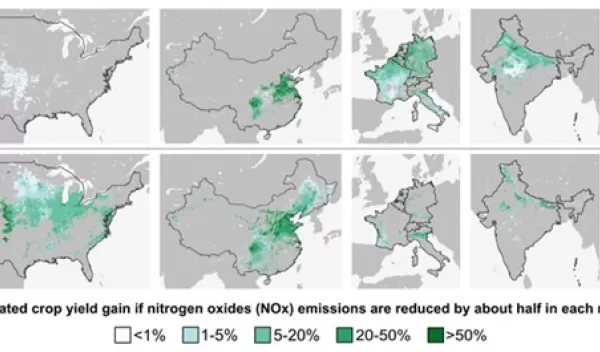
Less air pollution leads to higher crop yields, study shows
Increasing agricultural productivity usually depends on adding something, such as fertilizer or water. Now, a Stanford University-led study reveals that removing one thing in particular -- a common air pollutant -- could lead to dramatic gains in crop yields.
The U.S. National Science Foundation-supported analysis, published in Science Advances, used satellite images to reveal how nitrogen oxides -- gases found in car exhaust and industrial emissions -- affect crop productivity. Its findings have important implications for increasing agricultural output and analyzing climate change mitigation costs and benefits around the world.
"Nitrogen oxides are invisible to humans, but new satellites have been able to map them with incredibly high precision," said study lead author David Lobell. "Since we can also measure crop production from space, this opened up the chance to rapidly improve our knowledge of how these gases affect agriculture in different regions."
Nitrogen oxides, or NOx, are among the most widely emitted pollutants in the world. These gases can directly damage crop cells and indirectly affect them through their role as precursors to formation of ozone, an airborne toxin known to reduce crop yields, and particulate matter aerosols that can absorb and scatter sunlight away from crops.
While scientists have had a general understanding of nitrogen oxides' potential for damage, little is known about their actual impacts on agricultural productivity. Past research has been limited by a lack of overlap between air monitoring stations and agricultural areas, and confounding effects of different pollutants, among other challenges to ground-based analysis.
To avoid these limitations, Lobell and his colleagues combined satellite measures of crop greenness and nitrogen dioxide levels for 2018-2020. Nitrogen dioxide is the primary form of NOx and a good measure of total NOx. Although NOx is invisible to humans, nitrogen dioxide has a distinct interaction with ultraviolet light that has enabled satellite measurements of the gas at a much higher spatial and temporal resolution than for any other air pollutant.
"In addition to being more easily measured than other pollutants, nitrogen dioxide has the nice feature of being a primary pollutant, meaning it is directly emitted rather than formed in the atmosphere," said study co-author Jennifer Burney of the University of California, San Diego. "That means relating emissions to impacts is much more straightforward than for other pollutants."
Based on their observations, the researchers estimated that reducing NOx emissions by about half in each region would improve yields by nearly 10% for both winter and summer crops in Western Europe, and roughly 8% for summer crops and 6% for winter crops in India. North and South America generally had the lowest NOx exposures. Overall, the effects seemed most negative in seasons and locations where NOx likely drives ozone formation.
"The actions you would take to reduce NOx, such as vehicle electrification, overlap closely with the types of energy transformations needed to slow climate change and improve local air quality for human health," said Burney. "The main take-home from this study is that the agricultural benefits of these actions could be really substantial, enough to help ease the challenge of feeding a growing population."
Added Manda Adams, a program director in NSF’s Division of Atmospheric and Geospace Sciences, “This result is an example of how coupled the human system is with Earth system processes. Actions taken by society to reduce NOx emissions may be aimed at human health and slowing greenhouse gases, with benefits to society.”


